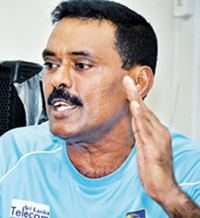The process of creating genuine pacemen

Anusha Samaranayake
In modern-day cricket, the need for a formidable fast bowling attack has become crucial to consistency and winning matches. Sri Lanka Cricket (SLC) has recognised this and prioritised the development of fast bowlers in recent years. A significant step in this direction is the establishment of the new Fast Bowling Academy at the High-Performance Centre (HPC) at the R. Premadasa Stadium, a move aimed at grooming the next generation of pacemen in the country.
Anusha Samaranayake, the newly appointed Head of Fast Bowling Department, elaborated on the importance of guiding young fast bowlers and emphasised the necessity of maintaining an extended pool of bowlers to ensure immediate replacements for the national team whenever required.
“My responsibility is to train fast bowlers and prepare them to represent Sri Lanka in all three formats,” Samaranayake explained.
“With the amount of cricket being played today, we need a larger pool of bowlers as we have a packed international schedule throughout the year. We will closely monitor the development of youngsters, starting from the Under-19 level.”
 The challenge of being a fast bowling coach lies in understanding the strengths and weaknesses of young bowlers. Samaranayake also highlighted the importance of monitoring their lifestyle, including diet, training methods, and the amount of rest required. Coaches must have a basic understanding of players’ family backgrounds to foster open communication.
The challenge of being a fast bowling coach lies in understanding the strengths and weaknesses of young bowlers. Samaranayake also highlighted the importance of monitoring their lifestyle, including diet, training methods, and the amount of rest required. Coaches must have a basic understanding of players’ family backgrounds to foster open communication.
Samaranayake stressed the importance of adjusting to different formats of the game. In Tests, bowlers must focus on consistent line and length, setting up batsmen to make mistakes and taking 20 wickets to win the match. In One Day Internationals, the goal is to reduce runs, build pressure, and take wickets. In T20s, finding the right line and length to increase wicket-taking opportunities is crucial. The coach’s role becomes vital in helping young bowlers adapt to these requirements.
At the HPC, the only prerequisite for fast bowlers is talent. The coaches there will guide, monitor, and teach all necessary bowling techniques. However, the initial development of a fast bowler lies within the school cricket system. School coaches must be trained to identify potential fast bowlers and correct any flaws in their bowling action early on.
Samaranayake noted that an illegal bowling action—where a player throws the ball instead of bowling it, as defined by the ICC—can be corrected with technology, but this process requires time. The bowler must commit to practicing with the corrected action over an extended period under the coach’s supervision before returning to competitive cricket.
Fast bowlers fall into
three categories:
n Express Pacers: Bowlers who rely on speed to unsettle batsmen, like Matheesha Pathirana and Lahiru Kumara.
n Swing Bowlers: Those who bowl at a slightly slower pace but rely on swing to take wickets, such as Chaminda Vaas and Nuwan Kulasekara.
n Fast-Medium Bowlers: Those who bowl at speeds between 135 to 145 kmph and are consistent wicket-takers globally, like Asitha Fernando.
The HPC coaches young bowlers help identify which category they belong to and guide their development accordingly. Samaranayake emphasised that fast bowlers shouldn’t rely solely on favourable conditions; they must develop variations to adapt to any pitch.
While speed is essential, Samaranayake pointed out that the ability to pitch the ball according to the situation is just as important. Techniques like controlling the swing and generating speed using ground force and proper hip alignment are critical.
The run-up is also crucial in a fast bowler’s action, generating momentum and contributing to speed, accuracy, and no-ball prevention. Samaranayake explained that identifying a bowler’s action—whether side-on, front-on, or semi-on—by observing the lower body is key, and technology is necessary to analyse and correct any errors in action.
In recent years, there has been a rise in bowlers with slingy actions, inspired by Lasith Malinga, Matheesha Pathirana, and Nuwan Thushara. Samaranayake emphasised the importance of carefully guiding these bowlers to ensure they maintain accuracy and speed while maximising the potential of their unique actions.
Samaranayake also addressed the importance of proper pitches for fast bowlers at school and domestic levels. Better pitches would allow fast bowlers to bowl long spells, build confidence, and reduce the risk of injuries. He urged for a plan to prepare more pitches suitable for fast bowlers, as only the SSC ground currently provides such conditions.
Injury and workload management have been under the spotlight recently. According to Samaranayake, adequate practice is the key to preventing breakdowns during matches. Fast bowlers must simulate match situations during practice to condition their bodies and minds.
He identified five primary causes of injury: over-bowling, under-bowling during practice, lifestyle (including diet, sleep, and rest), insufficient water intake, and incorrect bowling postures. A fast bowler must bowl at least 25 overs per week to condition the body and brain for competitive cricket.
“I believe that a fast bowler’s workload should not be restricted to a specific number of overs. They should bowl until they find their perfect rhythm,” Samaranayake stated, emphasising the importance of core muscle development during gym sessions.
Injury has hampered many fast bowlers in the national team, including Dushmantha Chameera, whose career has been constantly affected by a faulty bowling action, leading to muscle damage. Samaranayake and his team have been working closely with Chameera to help him regain confidence with a newly corrected action.
The ultimate goal of the new Fast Bowling Academy is to ensure that there is always a pool of quality fast bowlers ready for national selection, creating a competitive environment that pushes current players to maintain their fitness and performance. With more than 20 fast bowlers currently training at the academy, Samaranayake expressed confidence in the future.


